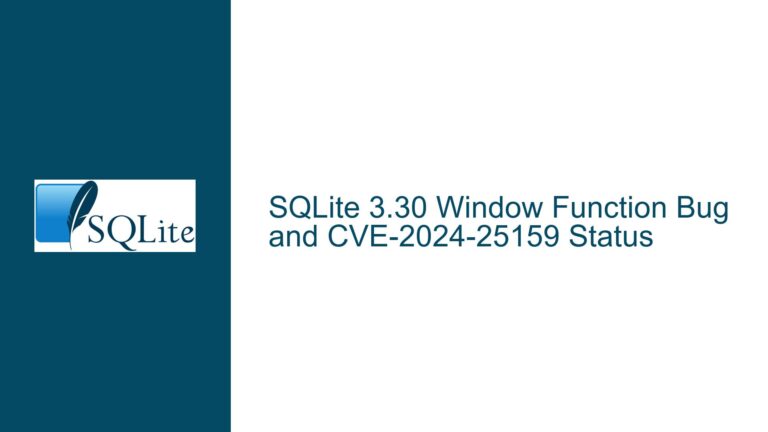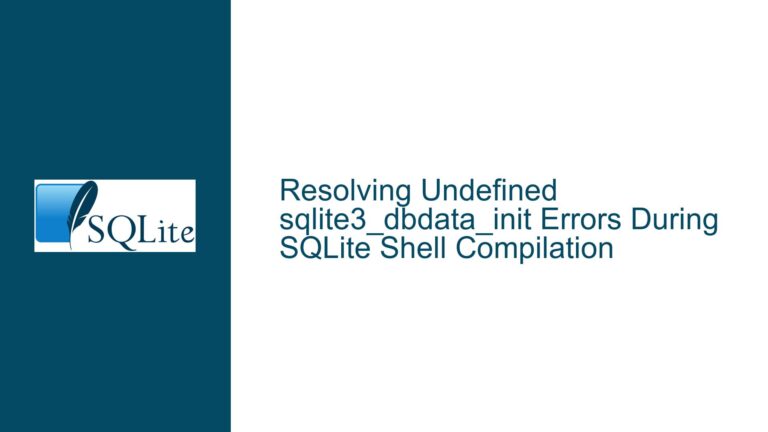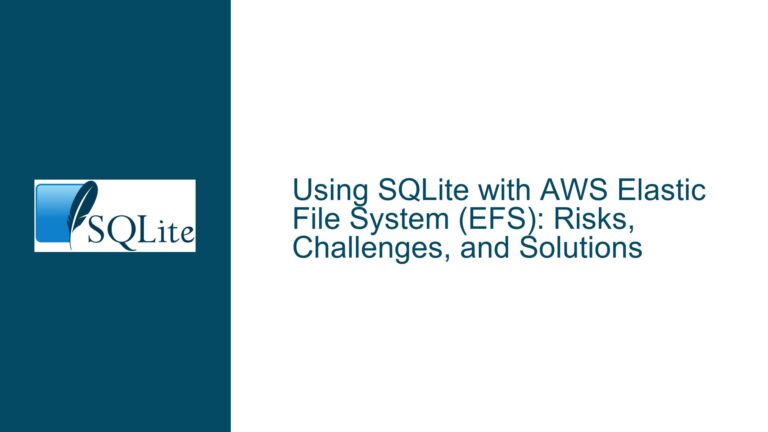Creating and Attaching a Database in SQLite When Main DB is Read-Only
Issue Overview: SQLITE_CANTOPEN and Access Mode Errors When Attaching a Database to a Read-Only Main Database
When working with SQLite, a common scenario involves attaching a secondary database to a primary (main) database using the ATTACH statement. This operation is typically straightforward, but complications arise when the main database is opened in read-only mode. The primary issue manifests as an SQLITE_CANTOPEN (14) error, indicating that SQLite is unable to open the secondary database for writing. Attempting to resolve this by specifying a URI with the mode=rwc parameter results in another error: access mode not allowed: rwc (1). This suggests that the requested access mode is incompatible with the read-only nature of the main database connection.
The core of the problem lies in the interplay between the access modes of the main database and the attached database. SQLite enforces strict access controls to ensure data integrity, and these controls become particularly restrictive when the main database is opened in read-only mode. The ATTACH statement, by default, inherits the access mode of the main database connection. This inheritance mechanism is designed to prevent unintended modifications to the attached database when the main database is in a read-only state. However, this behavior can be counterintuitive for developers who need to create or modify an attached database while the main database remains read-only.
The error access mode not allowed: rwc (1) further complicates the issue. This error indicates that the requested read-write-create (rwc) mode is not permitted under the current configuration. The rwc mode is typically used to create a new database file if it does not already exist, and to open it in read-write mode. However, when the main database is read-only, SQLite restricts the attached database from being opened in a mode that allows writing or creation. This restriction is in place to maintain the integrity of the read-only main database and to prevent any potential conflicts or data corruption.
Understanding the nuances of SQLite’s access modes and how they interact with the ATTACH statement is crucial for resolving this issue. The read-only mode of the main database imposes limitations on the operations that can be performed on attached databases, and these limitations must be carefully navigated to achieve the desired outcome. The following sections will explore the possible causes of these errors and provide detailed troubleshooting steps and solutions to address them.
Possible Causes: Inheritance of Access Modes and URI Parameter Restrictions
The SQLITE_CANTOPEN (14) and access mode not allowed: rwc (1) errors are rooted in the way SQLite handles access modes and URI parameters when attaching a database to a read-only main database. The primary cause of these errors is the inheritance of access modes from the main database connection to the attached database. When the main database is opened in read-only mode, SQLite enforces this mode on all attached databases, preventing any write operations. This inheritance mechanism is designed to maintain consistency and prevent unintended modifications to the attached databases.
Another contributing factor is the use of URI parameters in the ATTACH statement. The mode=rwc parameter is intended to open the database in read-write-create mode, allowing the creation of a new database file if it does not exist. However, when the main database is read-only, SQLite restricts the use of this parameter, resulting in the access mode not allowed: rwc (1) error. This restriction is in place to prevent any potential conflicts or data corruption that could arise from attempting to write to an attached database while the main database is in a read-only state.
The interaction between the main database’s access mode and the URI parameters in the ATTACH statement creates a complex scenario that requires careful consideration. The read-only mode of the main database imposes limitations on the operations that can be performed on attached databases, and these limitations must be understood and navigated to achieve the desired outcome. The following section will provide detailed troubleshooting steps and solutions to address these issues and enable the creation and attachment of a database when the main database is read-only.
Troubleshooting Steps, Solutions & Fixes: Creating and Attaching a Database with a Read-Only Main Database
To resolve the SQLITE_CANTOPEN (14) and access mode not allowed: rwc (1) errors when attempting to create and attach a database to a read-only main database, a multi-step approach is required. This approach involves understanding the limitations imposed by the read-only mode, exploring alternative methods for creating and attaching databases, and implementing best practices to ensure data integrity and consistency.
Step 1: Understanding the Limitations of Read-Only Mode
The first step in troubleshooting this issue is to fully understand the limitations imposed by the read-only mode of the main database. When the main database is opened in read-only mode, SQLite enforces this mode on all attached databases, preventing any write operations. This means that any attempt to create or modify an attached database will result in an SQLITE_CANTOPEN (14) error. Additionally, the use of URI parameters such as mode=rwc is restricted, leading to the access mode not allowed: rwc (1) error.
To work around these limitations, it is necessary to separate the creation of the secondary database from the attachment process. This can be achieved by creating the secondary database using a separate connection that is not read-only, and then attaching it to the main database connection. This approach ensures that the secondary database is created and modified independently of the read-only main database, while still allowing it to be accessed and queried through the main database connection.
Step 2: Creating the Secondary Database with a Separate Connection
The second step involves creating the secondary database using a separate connection that is not read-only. This can be done by opening a new SQLite connection to the secondary database with the appropriate access mode (e.g., read-write-create). Once the secondary database is created and populated with the necessary data, the connection can be closed, and the secondary database can be attached to the main database connection.
Here is an example of how this can be done in code:
import sqlite3
# Open a new connection to create the secondary database
secondary_db_path = '/path/to/secondary.db'
conn_secondary = sqlite3.connect(secondary_db_path, uri=True)
# Create tables and populate data in the secondary database
cursor_secondary = conn_secondary.cursor()
cursor_secondary.execute('CREATE TABLE IF NOT EXISTS my_table (id INTEGER PRIMARY KEY, name TEXT)')
cursor_secondary.execute('INSERT INTO my_table (name) VALUES ("example")')
conn_secondary.commit()
# Close the secondary database connection
conn_secondary.close()
# Open the main database connection in read-only mode
main_db_path = '/path/to/main.db'
conn_main = sqlite3.connect(f'file:{main_db_path}?mode=ro', uri=True)
# Attach the secondary database to the main database connection
cursor_main = conn_main.cursor()
cursor_main.execute(f'ATTACH DATABASE "{secondary_db_path}" AS secondary_db')
# Query the attached secondary database
cursor_main.execute('SELECT * FROM secondary_db.my_table')
results = cursor_main.fetchall()
print(results)
# Close the main database connection
conn_main.close()
In this example, the secondary database is created and populated using a separate connection that is not read-only. Once the secondary database is ready, it is attached to the main database connection, which is opened in read-only mode. This approach ensures that the secondary database can be created and modified independently, while still being accessible through the main database connection.
Step 3: Implementing Best Practices for Data Integrity and Consistency
The final step involves implementing best practices to ensure data integrity and consistency when working with attached databases in a read-only main database environment. One important consideration is to ensure that the secondary database is properly synchronized with the main database, especially if the main database is updated or modified outside of the current session.
To achieve this, it is recommended to use transactions and appropriate locking mechanisms when creating and modifying the secondary database. This helps to prevent any potential conflicts or data corruption that could arise from concurrent access to the secondary database. Additionally, it is important to handle any errors or exceptions that may occur during the creation and attachment process, and to provide appropriate feedback to the user.
Another best practice is to document the process and rationale for creating and attaching the secondary database. This documentation should include details on the access modes used, the steps taken to ensure data integrity, and any potential limitations or caveats. This documentation can be invaluable for future maintenance and troubleshooting efforts.
Conclusion
Creating and attaching a database to a read-only main database in SQLite can be challenging due to the limitations imposed by the read-only mode and the restrictions on URI parameters. However, by understanding these limitations, using a separate connection to create the secondary database, and implementing best practices for data integrity and consistency, it is possible to achieve the desired outcome. The approach outlined in this guide provides a robust and reliable solution for working with attached databases in a read-only main database environment, ensuring that data can be accessed and queried without compromising the integrity of the main database.






